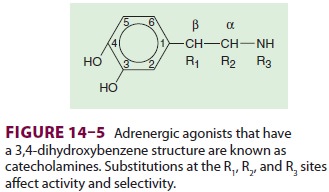Chapter: Clinical Anesthesiology: Clinical Pharmacology: Adrenergic Agonists & Antagonists
Adrenergic Agonists
Adrenergic Agonists
Adrenergic
agonists interact with varying specificity (selectivity) at α-
and β-adrenoceptors (Tables 14–1
and 14–2).
Overlapping
of activity complicates the predic-tion of clinical effects. For example,
epinephrine stimulates α1-,
α2-,
β1-,
and β2-adrenoceptors.
Its net effect on arterial blood pressure depends on the balance between α1-vasoconstriction,
α2-
and


β2-vasodilation,
and
β1-inotropic
influences. More-over, this balance changes at different doses.
Adrenergic
agonists can be categorized as direct or indirect. Direct agonists bind tothe
receptor, whereas indirect agonists increase endogenous neurotransmitter
activity. Mecha-nisms of indirect action include increased release or decreased
reuptake of norepinephrine. The differ-entiation between direct and indirect
mechanisms of action is particularly important in patients who

have
abnormal endogenous norepinephrine stores, as may occur with use of some
antihypertensive medications or monoamine oxidase inhibitors. Intraoperative
hypotension in these patients should be treated with direct agonists, as their
response to indirect agonists will be altered.
Another
feature distinguishing adrenergic ago-nists from each other is their chemical
structure. Adrenergic agonists that have a 3,4-dihydroxyben-zene structure (Figure 14–5)
are known as cat-echolamines. These drugs are typically short-acting because of
their metabolism by monoamine oxidase and catechol-O-methyltransferase. Patients taking monoamine oxidase inhibitors
or tricyclic antide-pressants may therefore demonstrate an exaggerated response
to catecholamines. The naturally occurring catecholamines are epinephrine,
norepinephrine, and DA. Changing the side-chain structure (R 1, R2,
R3) of naturally occurring catecholamines has led to the development
of synthetic catecholamines (eg, isoproterenol and dobutamine), which tend to
be more receptor specific.
Adrenergic
agonists commonly used in anes-thesiology are discussed individually below.
Note that the recommended doses for continuous infu-sion are expressed as
mcg/kg/min for some agents and mcg/min for others. In either case, these
recom-mendations should be regarded only as guidelines, as individual responses
are quite variable.
Related Topics